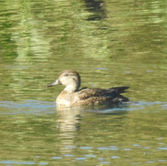Green-winged Teal
Common Name: Green-winged Teal.
Scientific Name: Anas Cracca.
What to look for? Look for a much smaller version of a Mallard duck. Breeding males have a cinnamon-colored head with a gleaming green crescent that extends from the eye to the back of the head. And males have a gray body and a vertical white stripe on the side. Females have a blocky body and are brown with cream-colored stripe at the rear. Both male and female have green wing patches in the secondaries (speculum). Their black bill is flattened and has a toothlike fringe on its edge. They have black legs and feet. Three of the toes are webbed to help with swimming.
Where can they be found at Carillon Stonegate Pond? You can find Green-winged Teal around here during spring and fall migration foraging around the water’s edge of our ponds. Your initial sighting may be “rump-up” as they forage with their heads into the pond.
How big are they? The Green-winged Teal averages around fourteen (14) inches in length. And their wingspan is approximately twenty-two (22) inches. They weigh in at around ten (10) ounces. A Green-winged Teal is dwarfed by a Mallard.
What are their flight patterns? Green-winged Teal are fast, agile flyers. They can take off straight from the water without running across the surface. Their wings are large in relation to their body weight, giving them the ability to lift easily from the surface of the water. In flight, both sexes flash deep-green wing patches (specula).
How else do they behave? Green-winged Teal are often seen around the edges of ponds, generally in a concealed spot to forage or rest. They are “dabbling ducks” - they feed in the water by tipping forward and grazing on underwater plants. They occasionally dive for food and to avoid predators. Green-winged Teal can take off straight from the water without running across the surface.
What’s for dinner? Green-winged Teal dabble to feed on the vegetative parts of aquatic plants (algae, duckweeds, pondweeds, etc.), seeds (sedges, pondweeds, grasses, etc.) and large amounts of aquatic invertebrates found in shallowly flooded wetlands. Hence, they love quickly refueling at Carillon Stonegate Pond as they migrate.
Where do they take up residence? Green-winged Teals are common migrants throughout Illinois, but rarely staying through the summer in northern Illinois. They reside across the U.S. – southern during winter and northern during summer. They can be found in marshes, ponds, and marshy lakes.
When and where do they breed and nest? Green-winged Teal breed throughout nearly all of Canada and Alaska as well as The Prairie Pothole Region in the northern Great Plains. Pair formation begins in early winter and continues during spring migration. Nesting habitat includes wetland areas within grasslands, such as shallow marshes, sloughs, flooded ditches, and temporary ponds. Females lay up to eight (8) or more eggs. Incubation is completed in approximately twenty-one days. The young leave the nest a few hours after hatching. Young fledge at about thirty-five (35) days.
Where do they migrate? Green-winged Teal are medium-distance migrants. They migrate from northern North America via all major flyways - Pacific, Central, Mississippi, and Atlantic - to reach wintering grounds from coastal British Columbia to as far south as Central America. Fall migration is much later than other ducks - mostly October to early December.
What is their conservation status? There is no concern. Populations of Green-winged Teal are numerous, and their population has increased over recent decades, according to waterfowl surveys by the U.S. Fish and Wildlife Service. Partners in Flight estimates a global breeding population of four million in North America.
Do they make any interesting sounds? Green-winged Teal males give a clear whistling call. Green-winged Teal females give a repeated, shrill quack – like a duck! Here is a link to the sounds of the Green-winged Teal.
Interesting Facts About the Green-winged Teal:
-
The little Green-winged Teal is the smallest dabbling duck in North America.
-
The Green-winged Teal gets its name from the green patch on its wings.
-
The oldest recorded Green-winged Teal was approximately 20 years old.
-
Green-winged Teals have closely spaced, comb-like projections called lamellae around the inner edge of the bill, which they use to filter tiny invertebrates from the water and capturing smaller food items than other dabbling ducks.
-
Green-winged Teal sometimes switch wintering sites from year to year - wintering in Texas one year and California in subsequent years.
-
A group of teal has many collective nouns, including a "coil", "dopping", "knob", "paddling", and "spring" of teal.
For more information on the Green-winged Teal and sources of information used in this blog (these are the sources that I am using to learn as I blog), please visit All About Birds, Audubon Society, Illinois DNR, Missouri Department of Conservation, NH PBS Nature Works, and Bird Watchers Digest. And the Cornell Lab of Ornithology provides a wonderful source of information for anyone interested in learning more about birds.
The Carillon at Stonegate community is very fortunate to have a variety of wetland, forest and prairie environments conducive to a variety of birds and other wildlife, plants and insects. Our community and the Kane County Forest Preserve do an exceptional job in maintaining this natural environment – both for the benefit of the birds and wildlife and for our residents to enjoy.
Take a hike and see what you can find – and identify!












